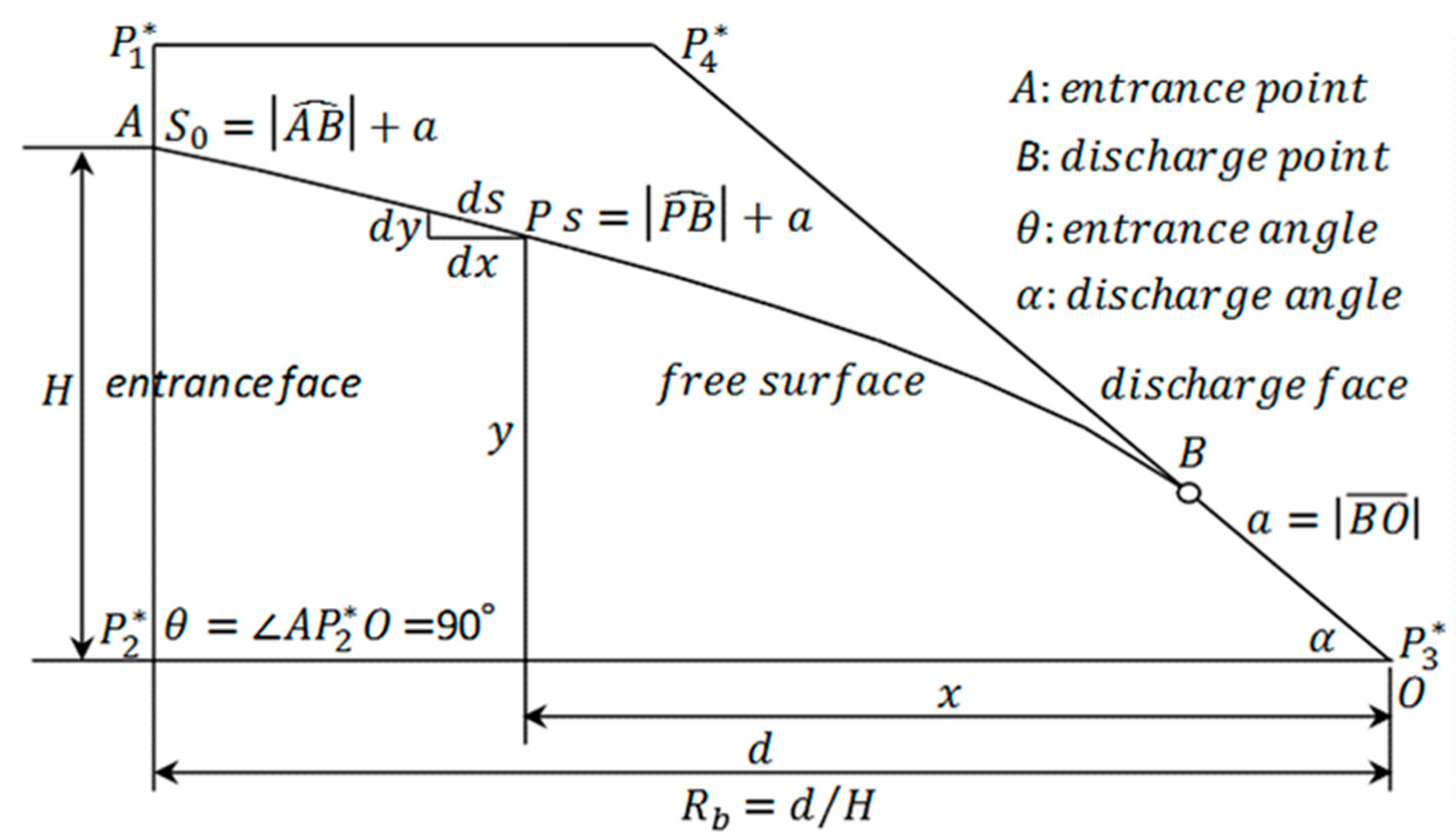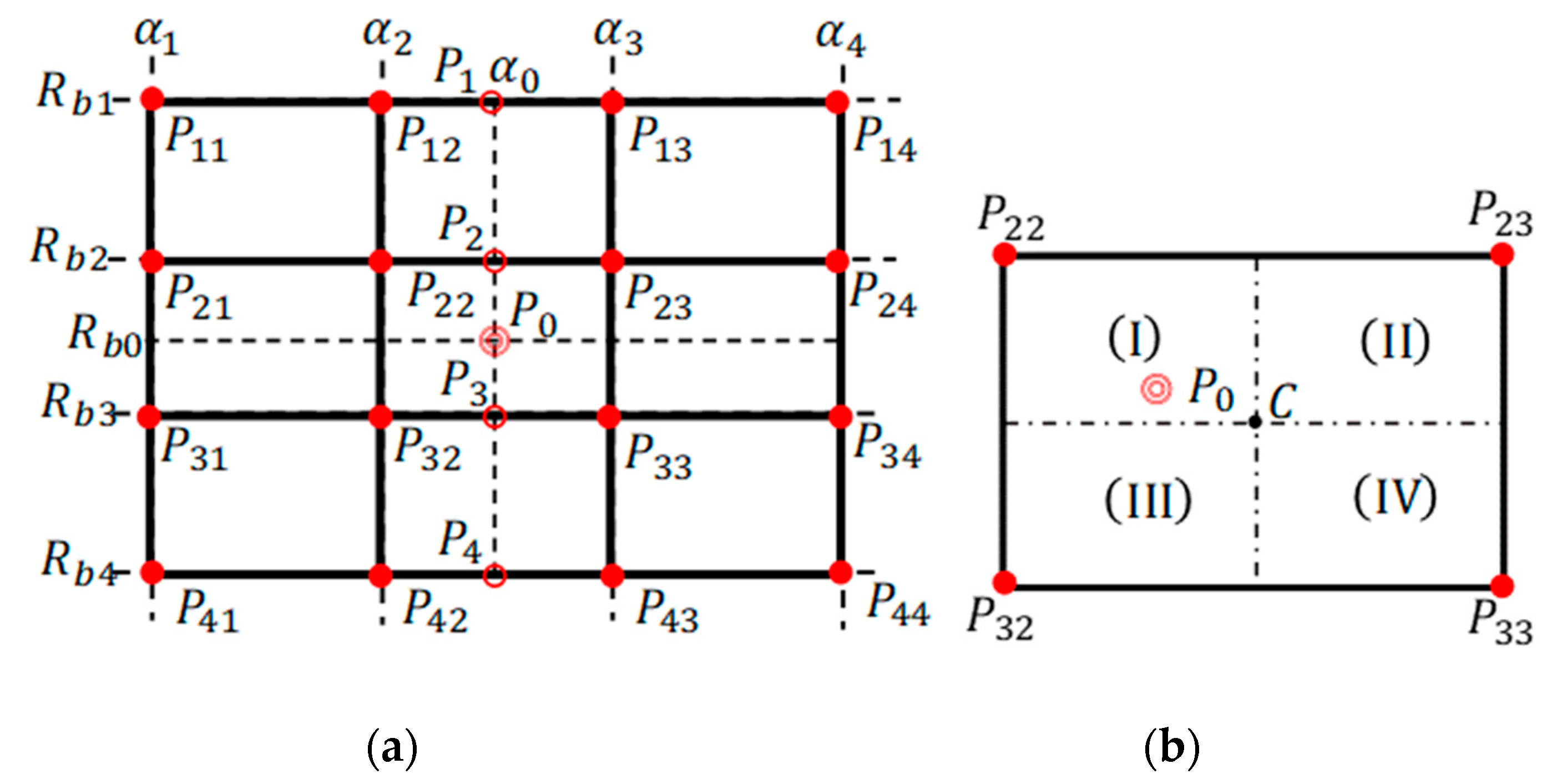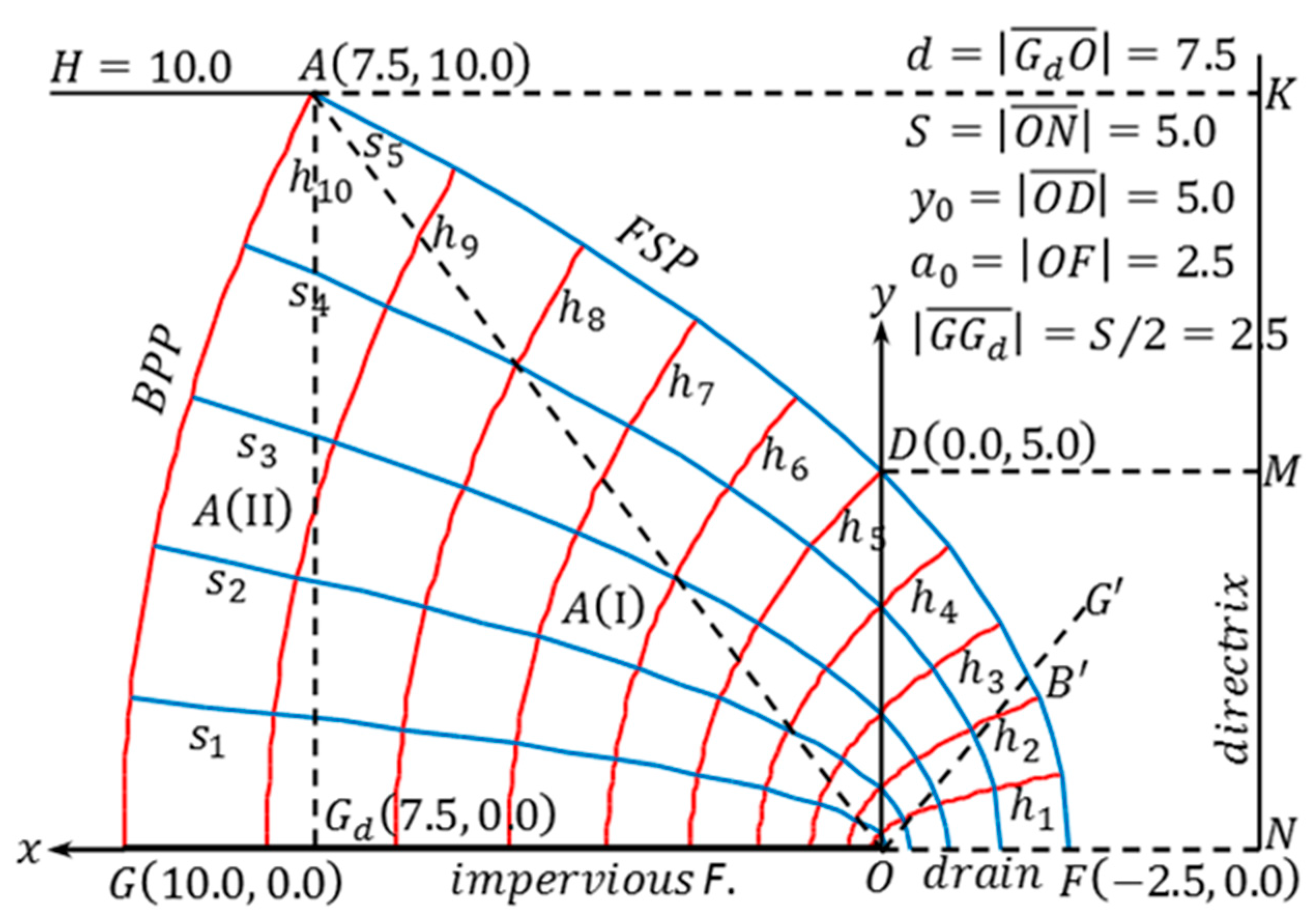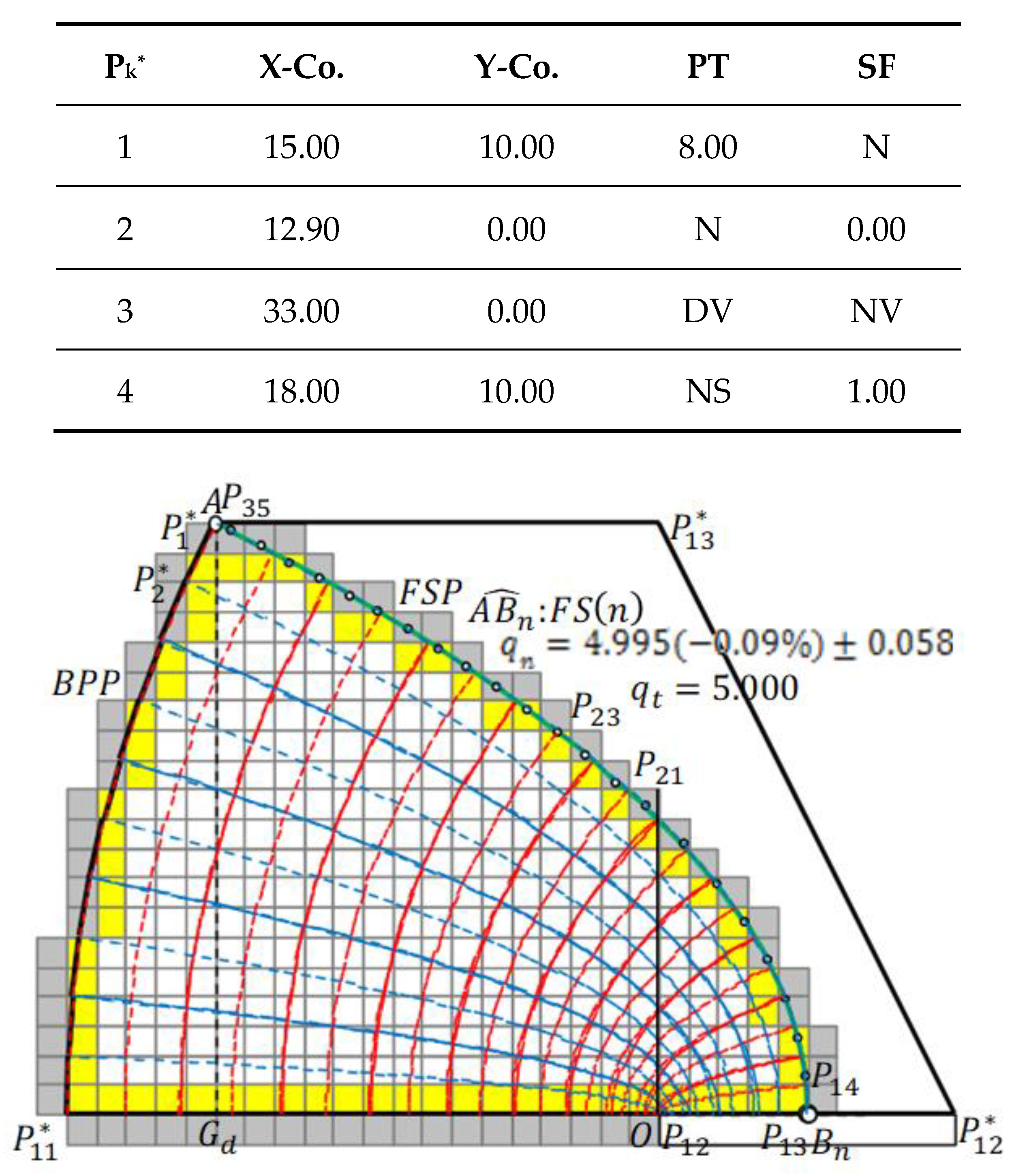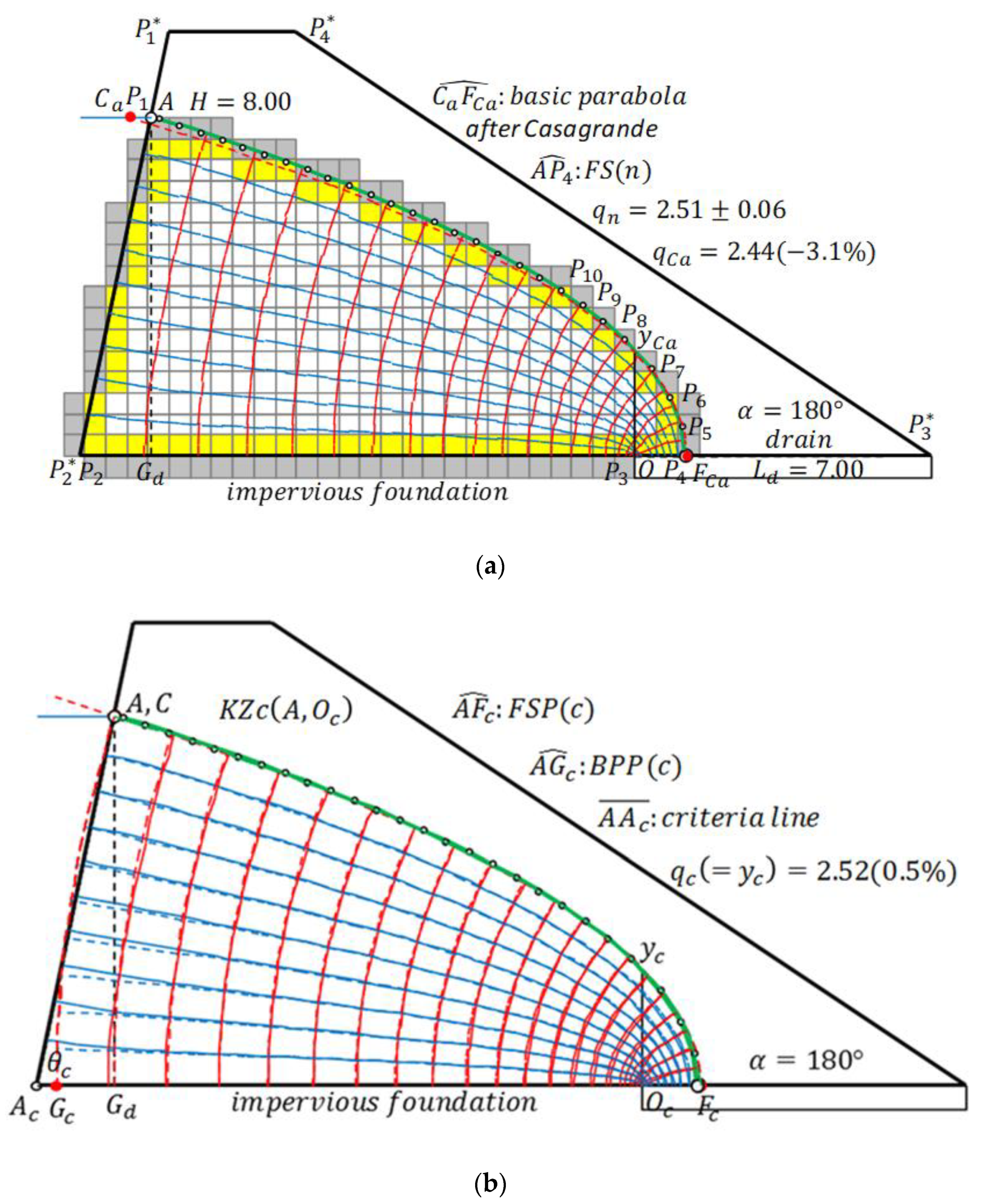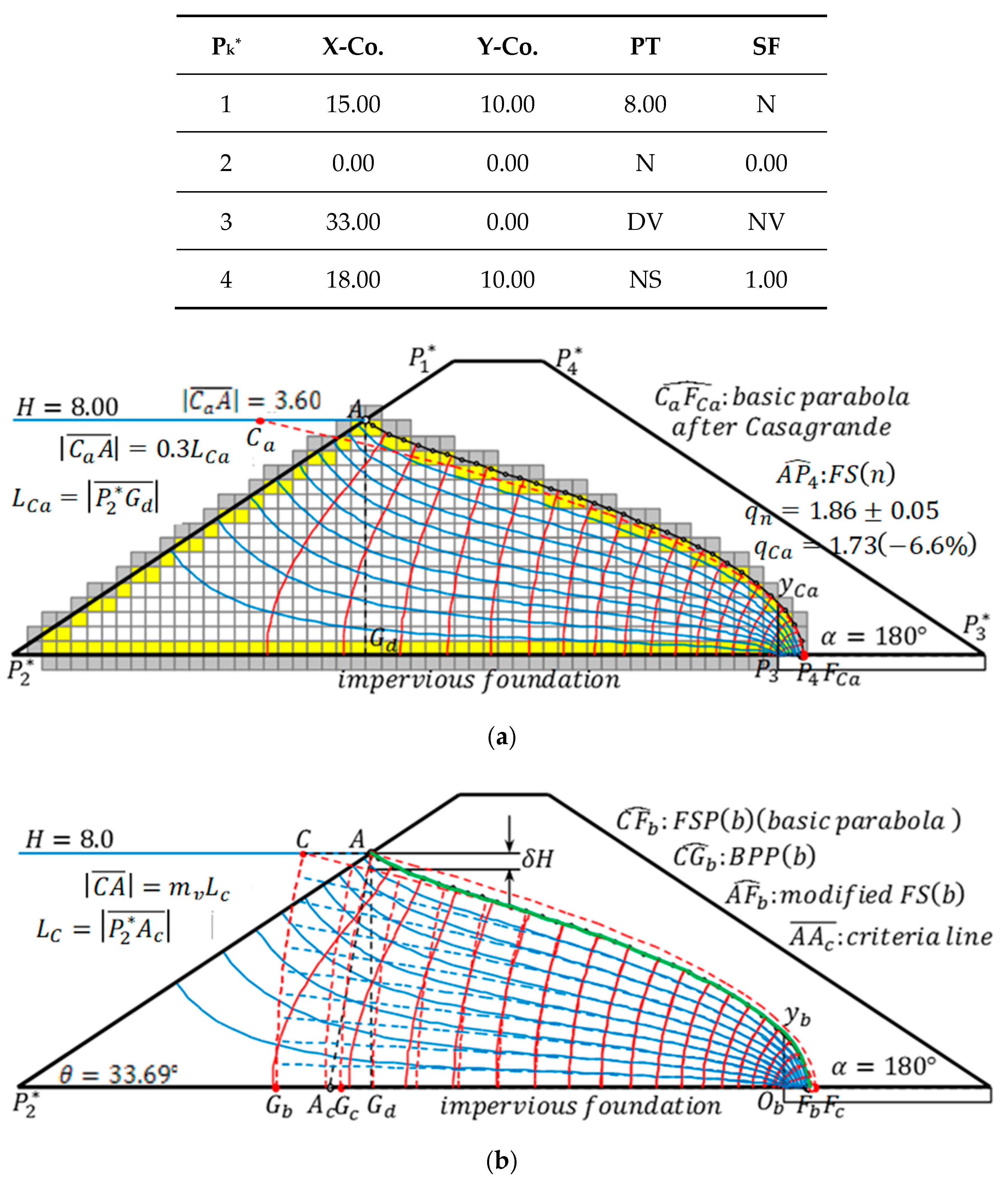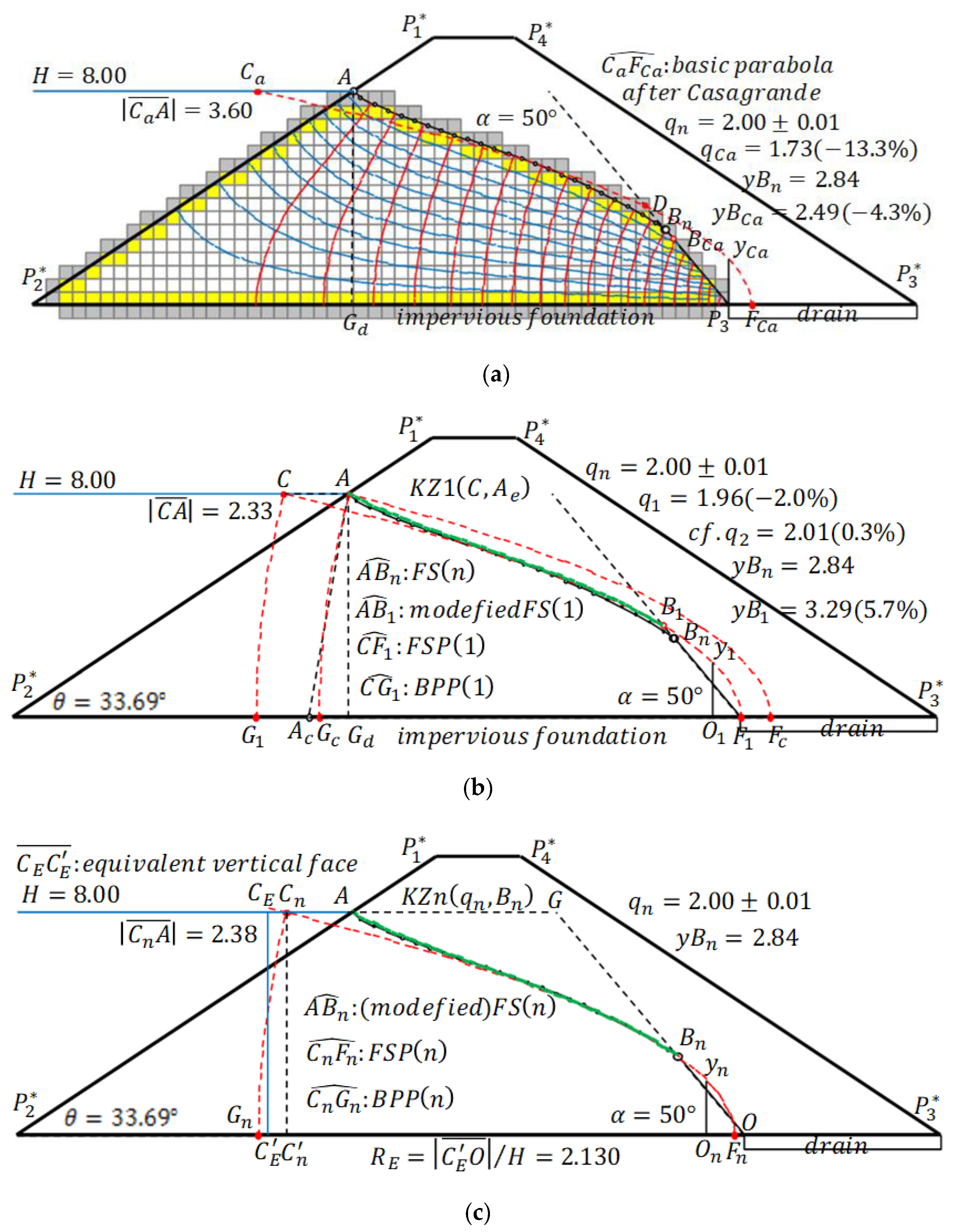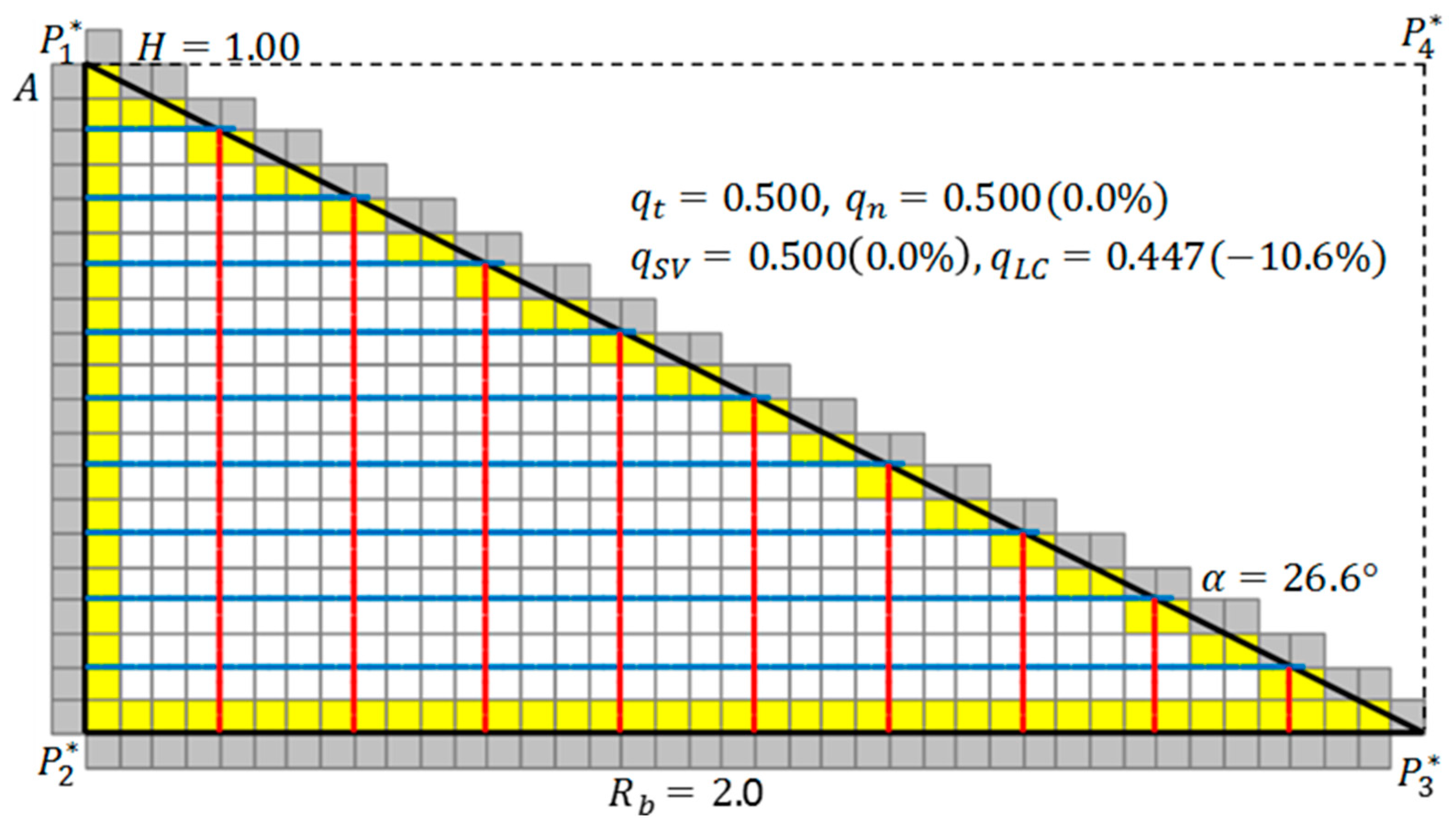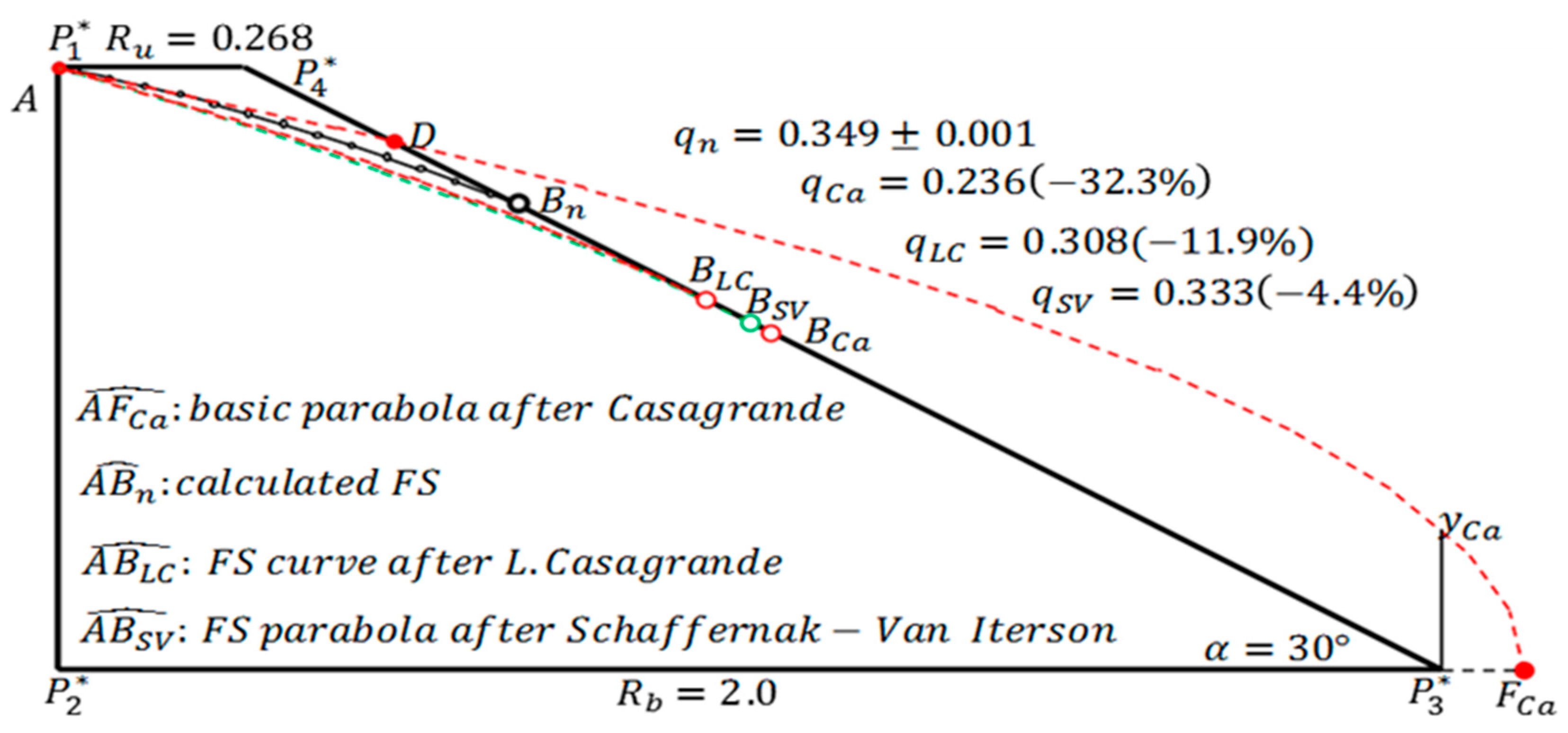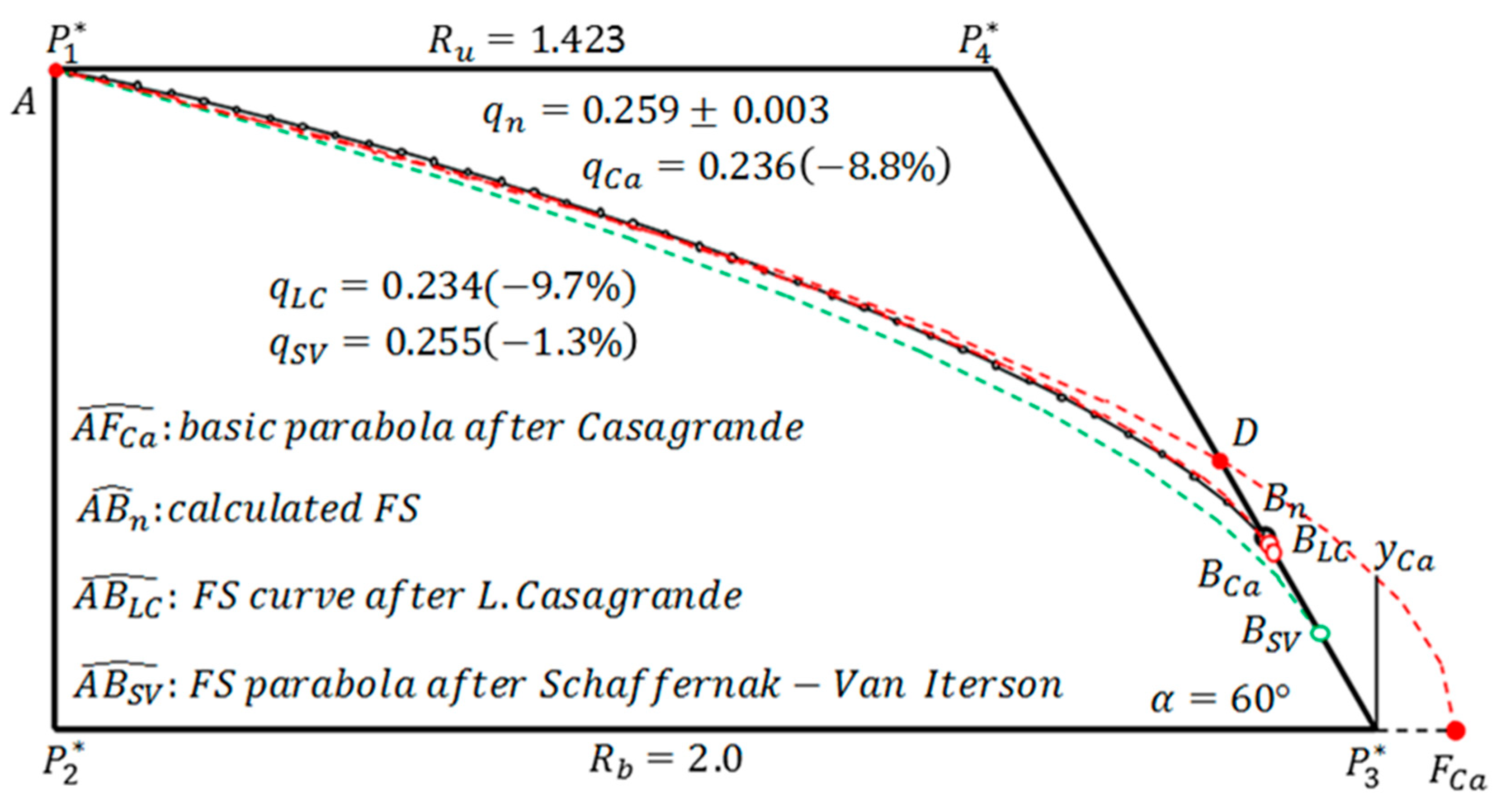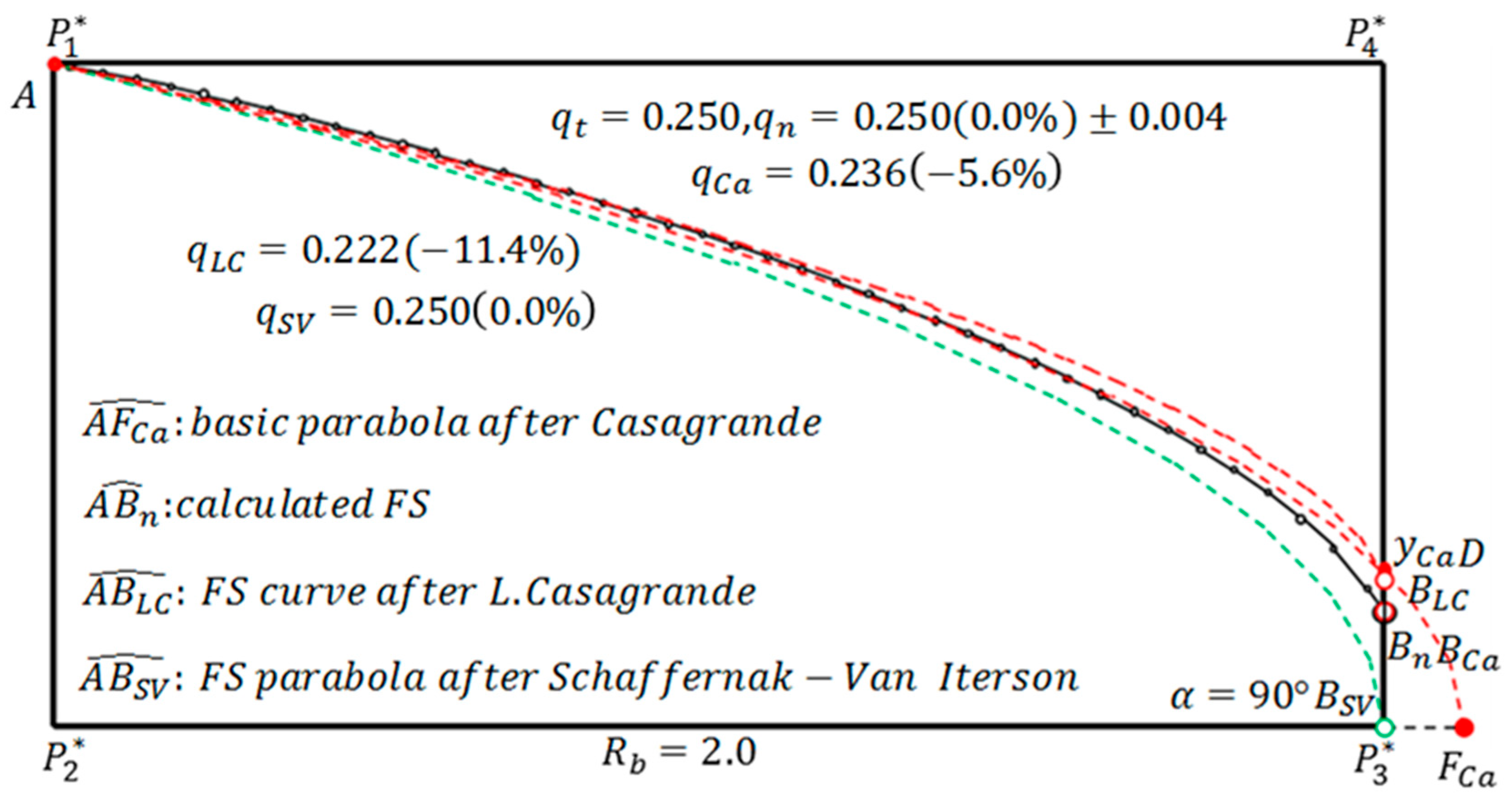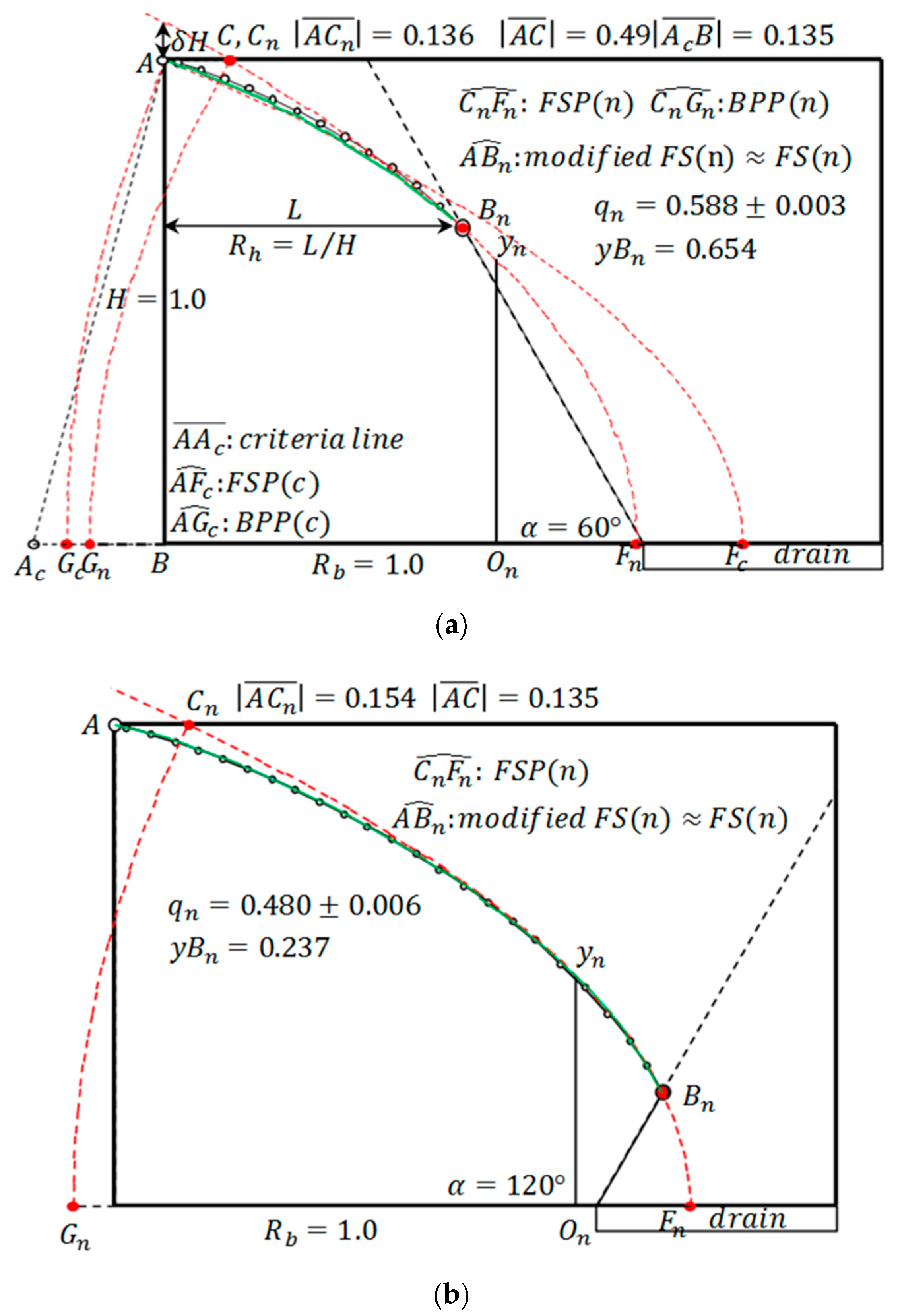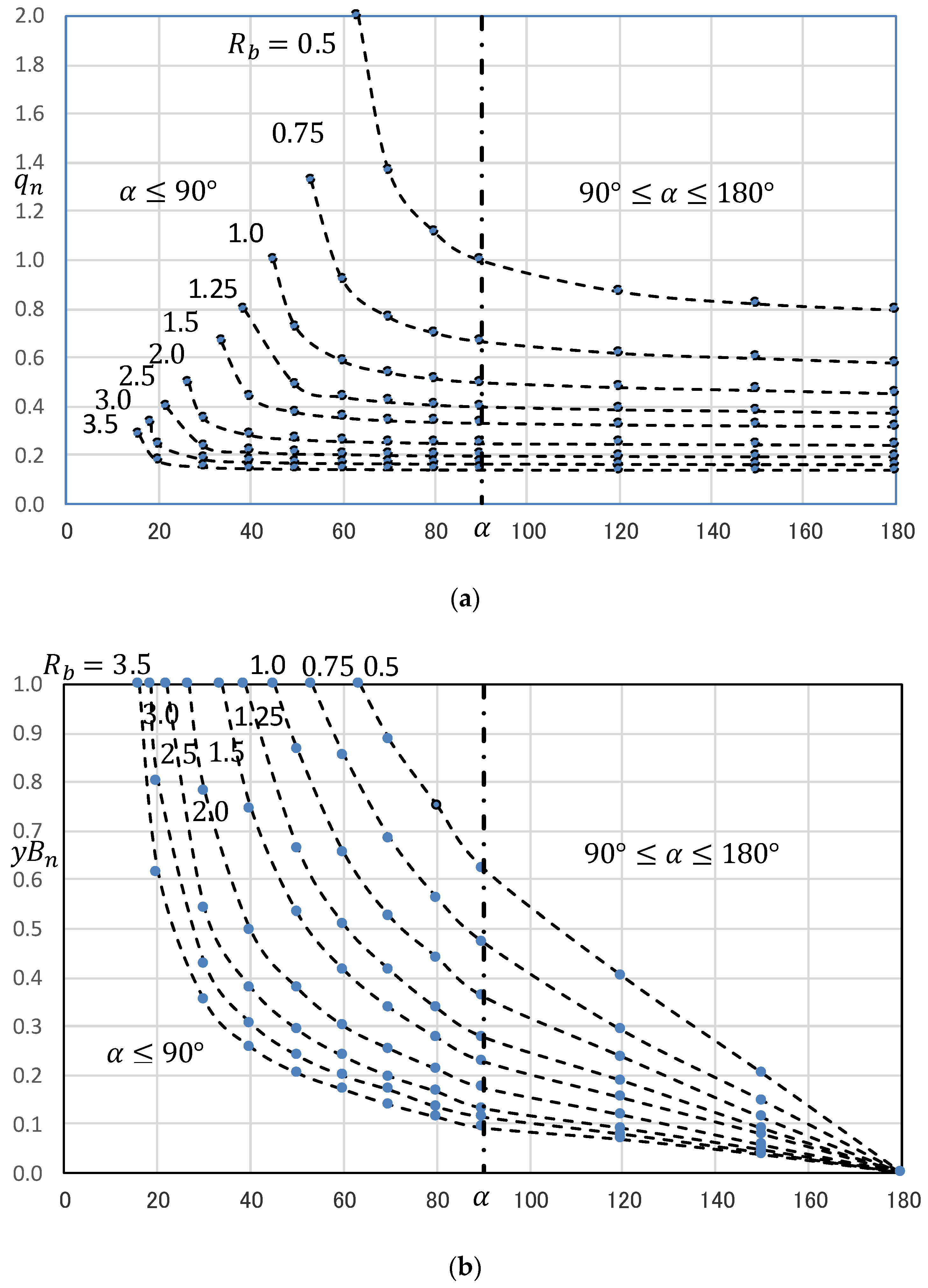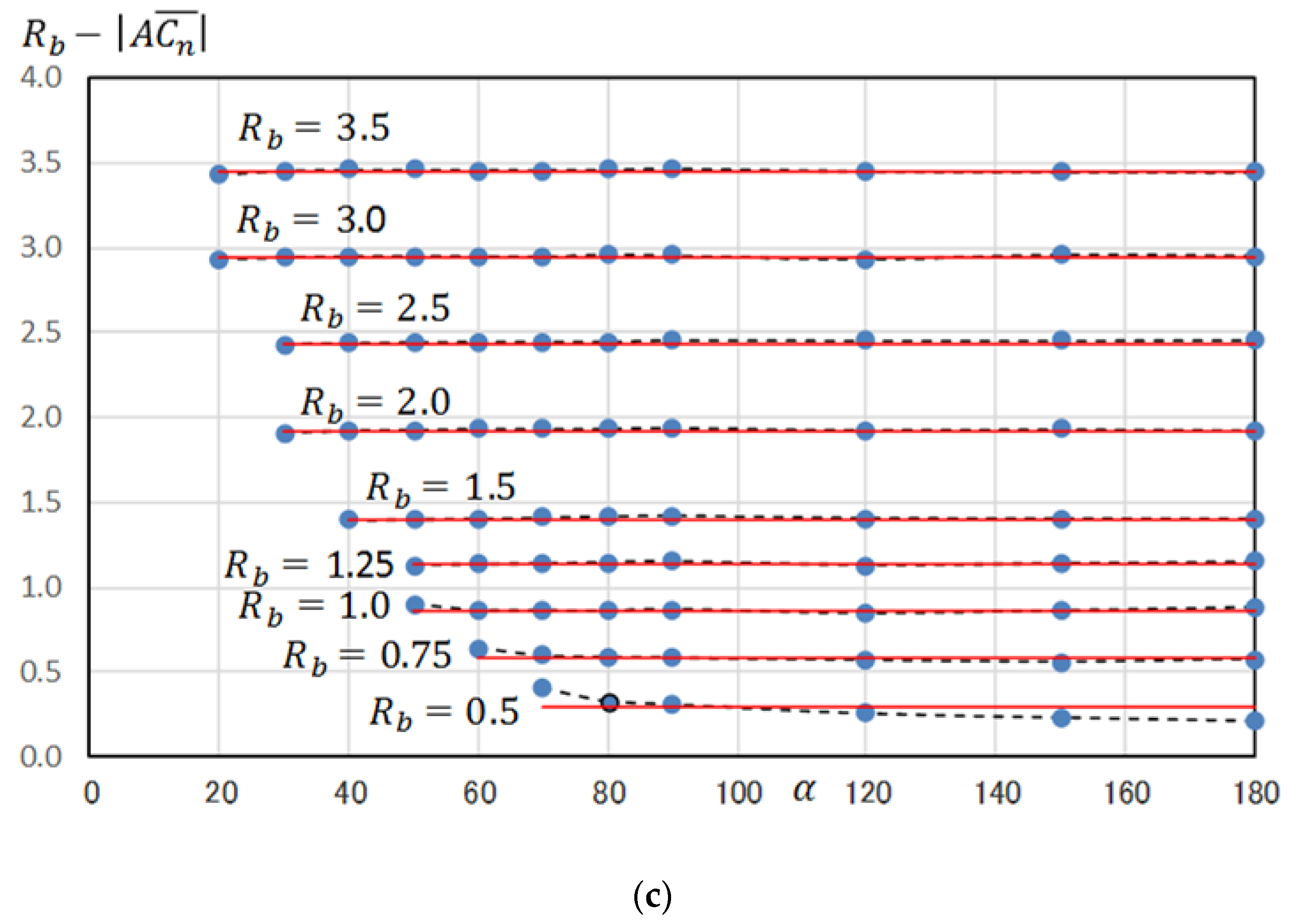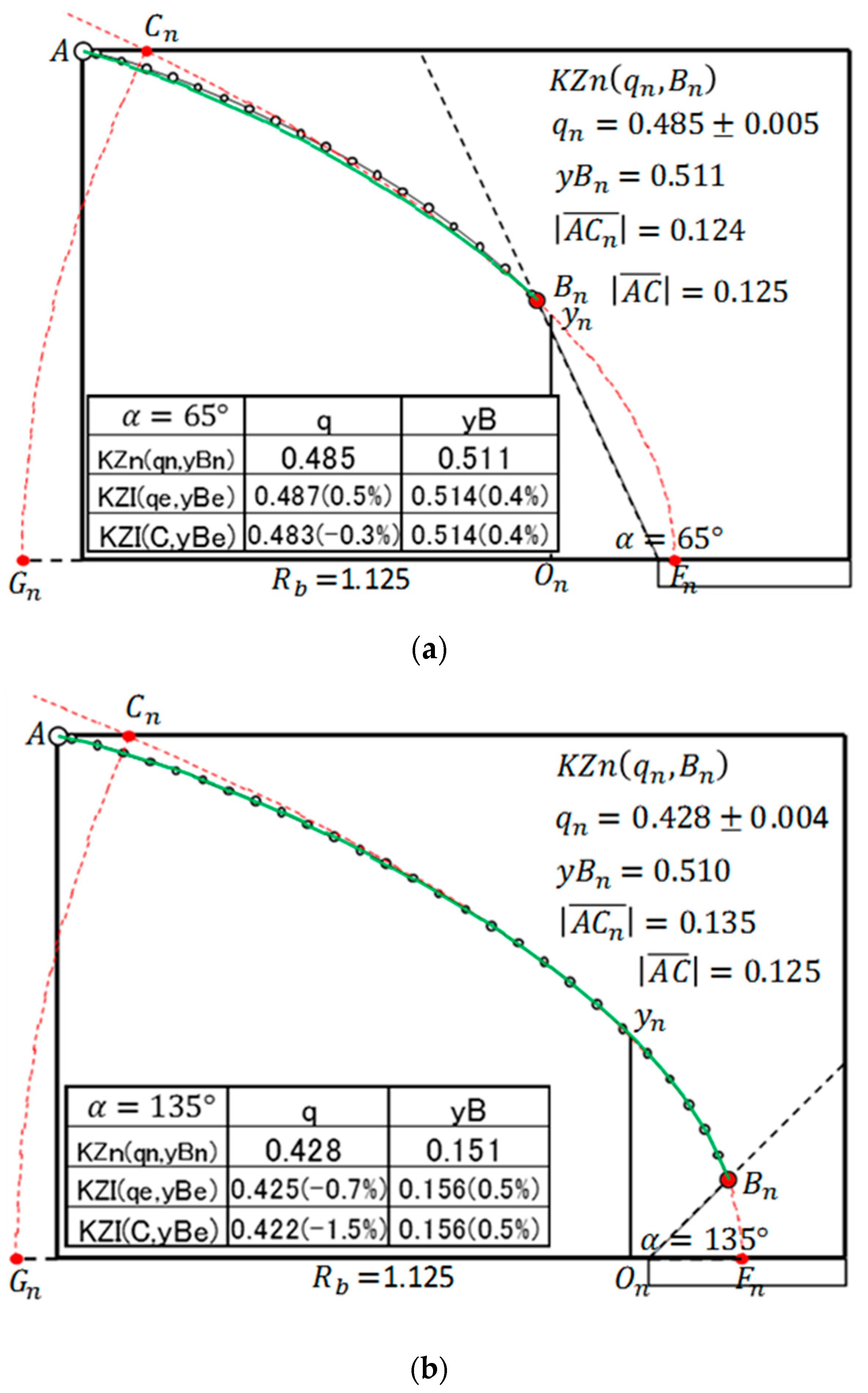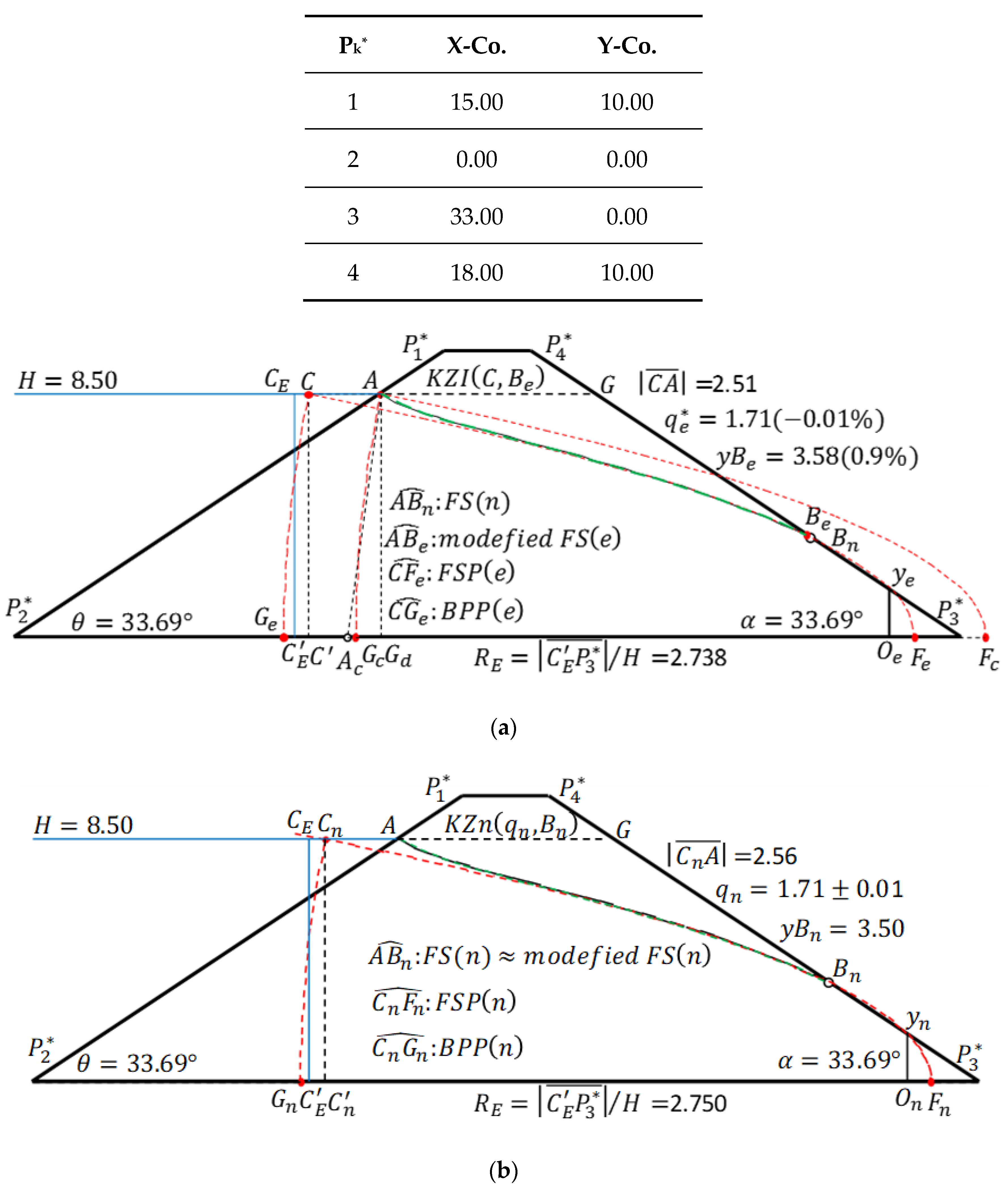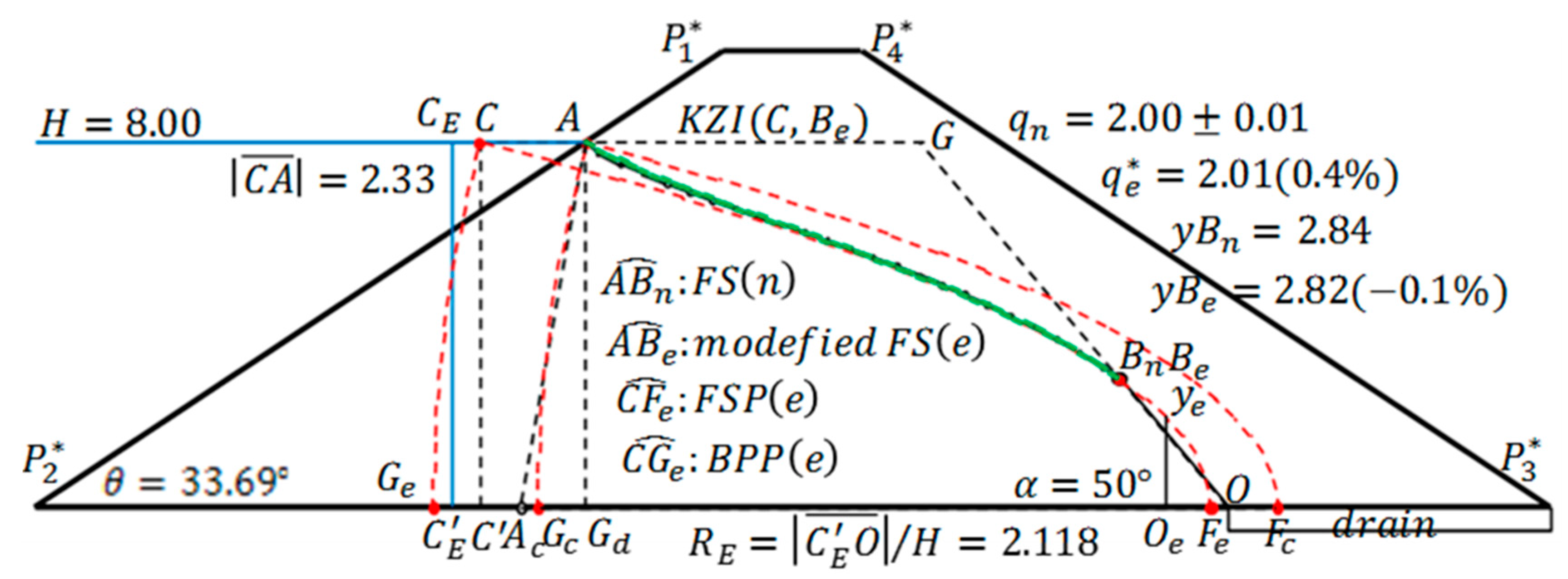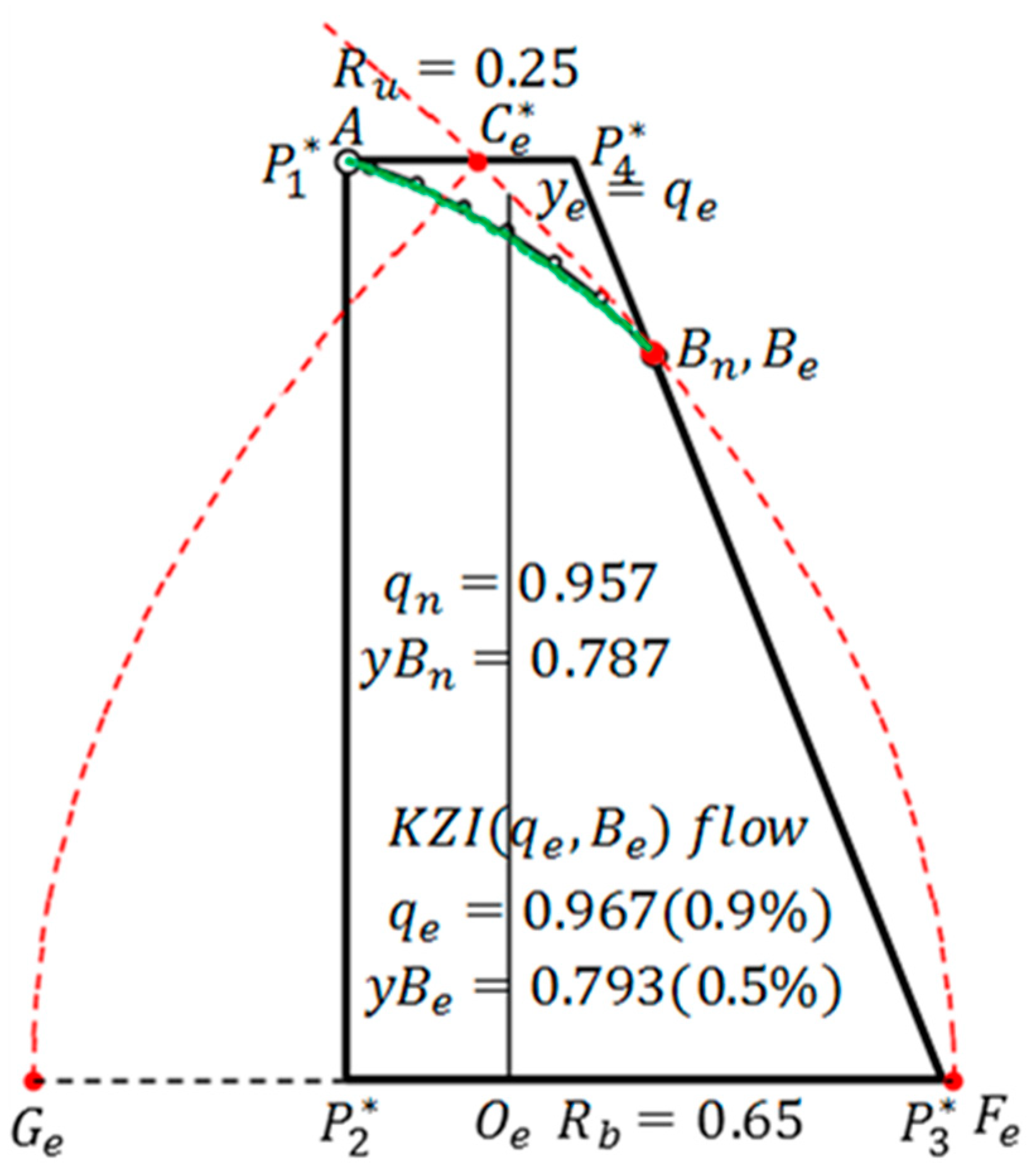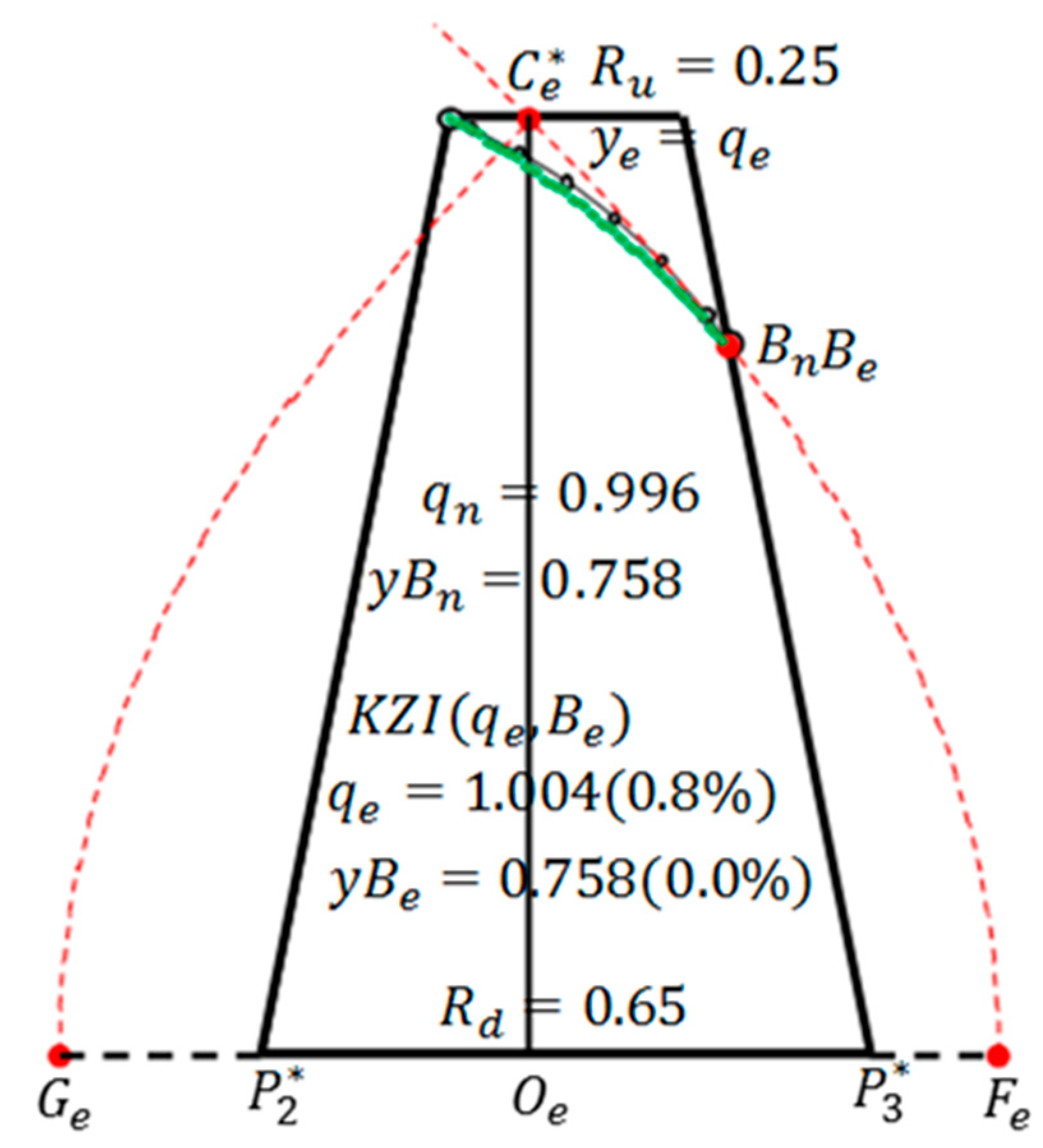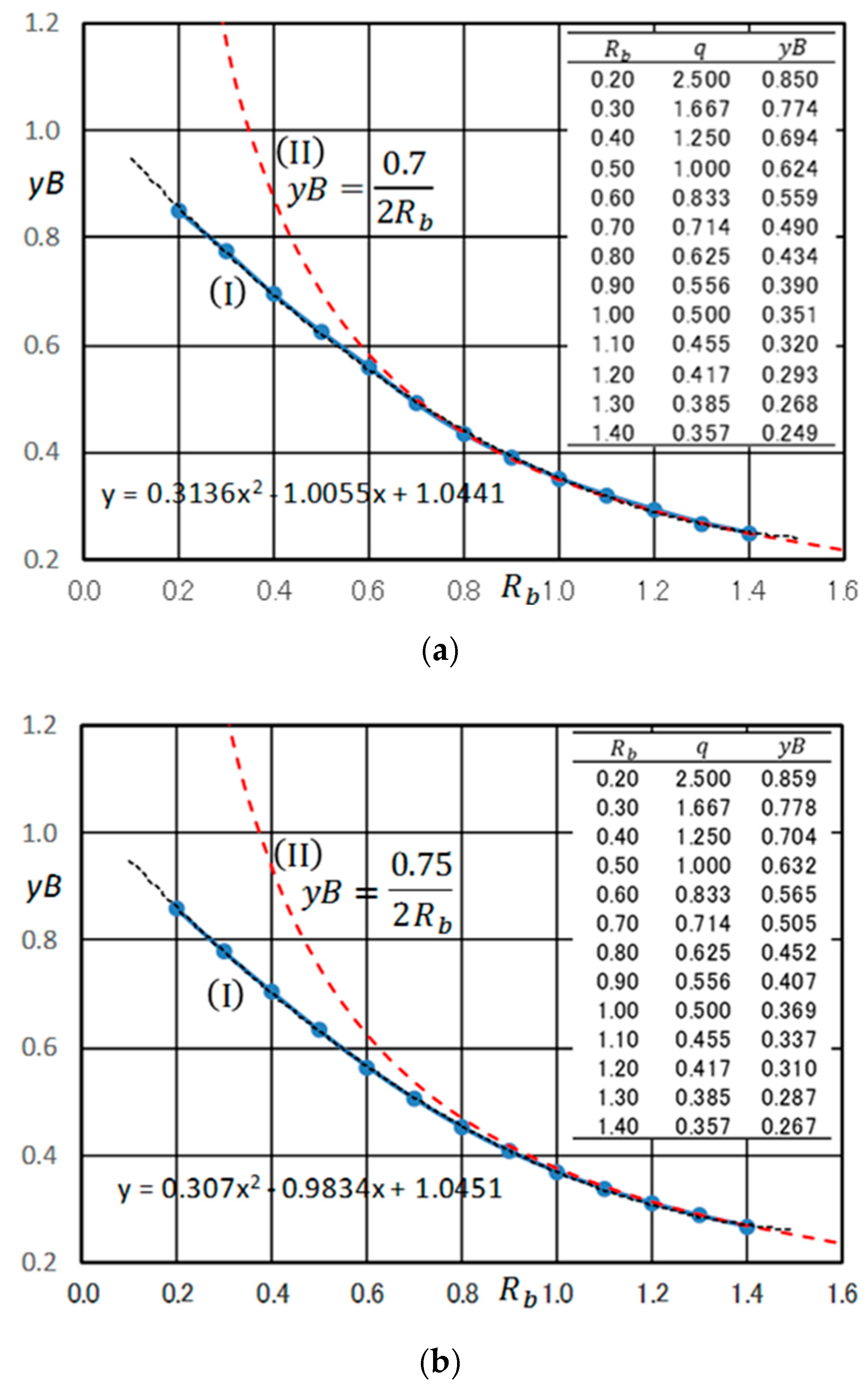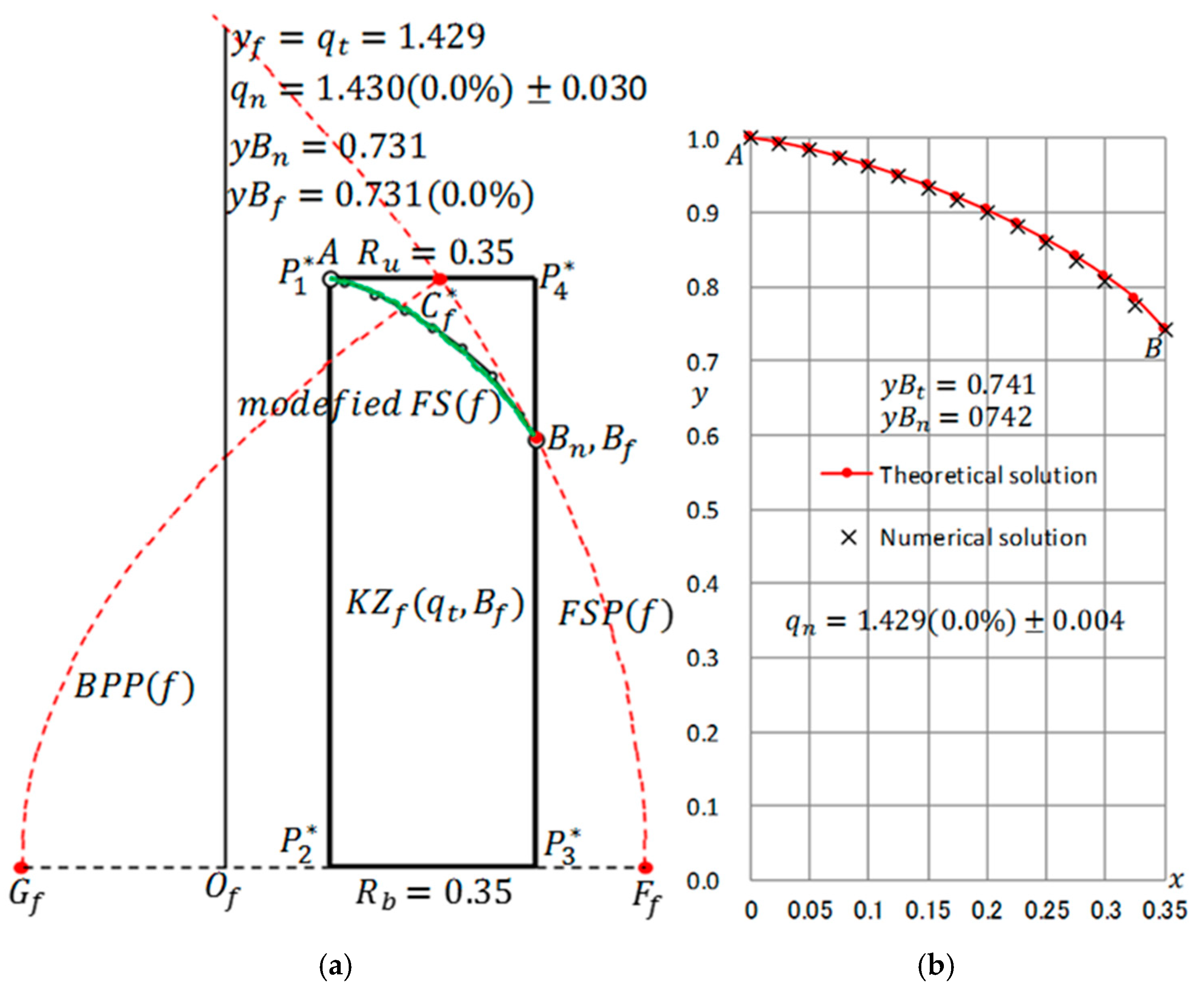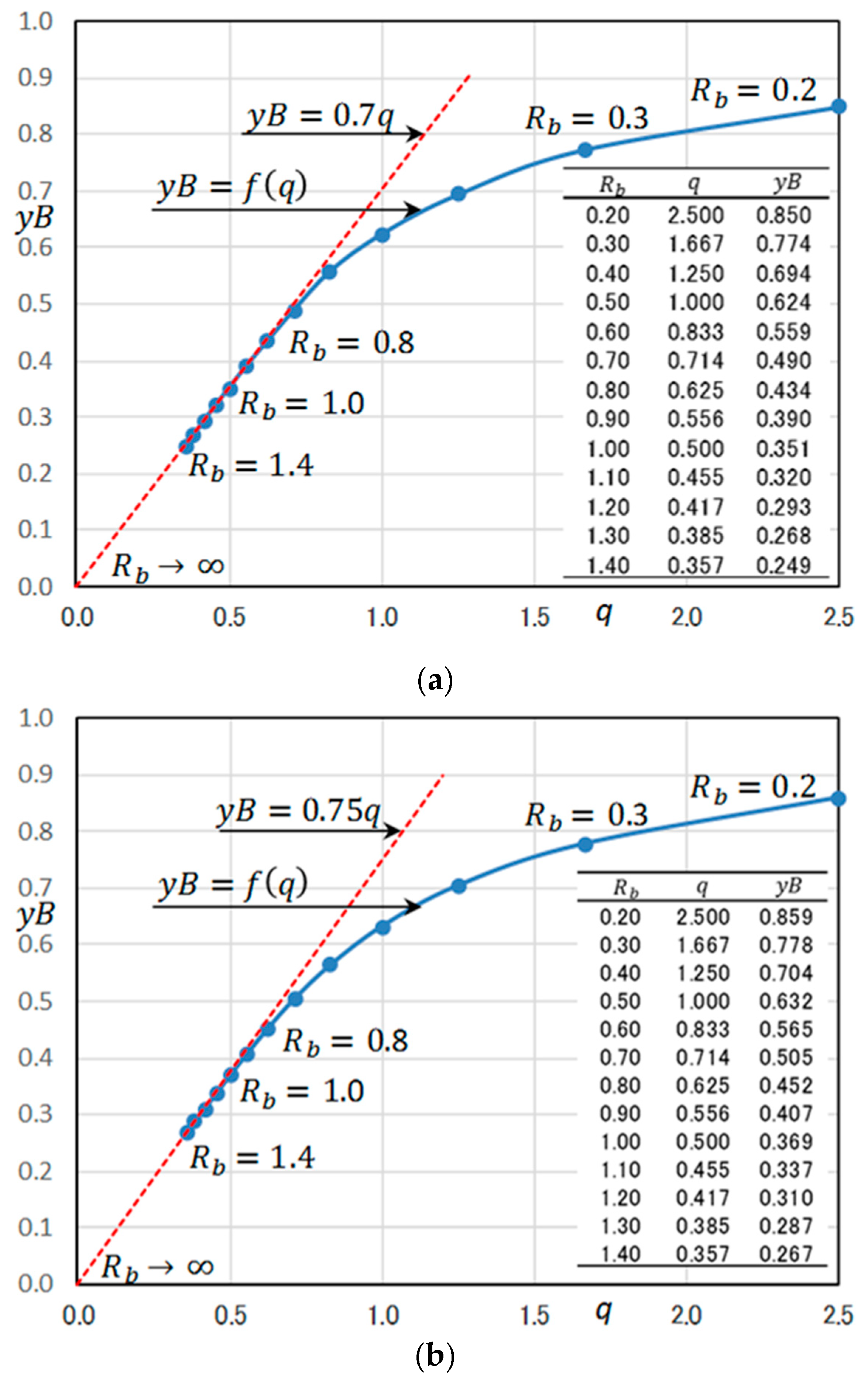1. Introduction
Conventionally, high-accuracy numerical analyses of seepage problems of earth dams have been implemented using the finite element method. Numerical analyses using the finite difference method (FDM) have been limited to cases where the calculation domains are comparatively simple. However, by applying the interpolation finite difference method (IFDM), two- and three-dimensional elliptic partial differential equations (PDEs) over complex domains with high speed and high accuracy can be freely solved [
1,
2,
3] The IFDM is composed of two kinds of methods [
3] (1) Algebraic Polynomial Interpolation Method (APIM), where finite difference schemes are formulated instantaneously over equally or unequally spaced grid points, and (2) Boundary Polynomial Interpolation Method (BPIM), where numerical calculations are executed only over equally spaced grid points, and the boundary interpolation is performed to match the boundary conditions. In the paper, the numerical calculations are executed by the IFDM-BPIM.
This method is adopted as a numerical analysis method for solving confined/unconfined seepage problems. In such problems, because of the adoption of IFDM-BPIM using the quadratic interpolation at the boundary, it has been shown that highly accurate numerical calculations are possible even in the FDM [
4,
5].
Empirical methods proposed in the first half of the previous century—(1) A. Casagrande method, (2) Schaffernak–Van Iterson method, and (3) L. Casagrande method—have been adopted in design standards [
6,
7] without sufficient verifications. Fukuchi (2018) [
5] summarized the critique of these empirical methods as follows.
“Many researchers have pointed out various problems in A. Casagrande’s method, and some have proposed alternatives (Uginchus, 1960 [
8]; Lo, 1971 [
9]; Browzin, 1976 [
10]). Several issues have since been raised. Shrivastava (2015) [
11] suggested a modified equation for the phreatic line in an earthen dam, which is much more accurate than that given by A. Casagrande. Salmasi and Jafari (2016) [
12] computed the locations of the free surface for 28 examples using the SEEP/W software (GEO-SLOPE 2009) [
13] and found that, in most cases, the Schaffernak–Van Iterson method has more than 20% error and A. Casagrande’s method has more than 30% error. Using SEEP/W, Jamel (2016) [
14] computed the discharges for 729 examples without a drain and found that A. Casagrande’s solution has more than 15% error.” Despite many criticisms of these empirical methods, attempts to construct a new empirical method have not yet been made.
The author has also confirmed that with these methods, even if the permissible error is set to 10%, sufficient calculation accuracy is not guaranteed. These empirical methods should be critically examined by comparing them with numerical calculation at its current state. In this study, an empirical estimation with a permissible error of a few percent is considered. With respect to discharge, it is defined that the absolute relative error of an empirical discharge (
) to the numerically calculated discharge (
) is within 3%; thereafter, the criterion is the numerically calculated discharge, specifically,
. With respect to the location of the free surface, the maximum calculation error usually occurs at the discharge point
B and is evaluated by its vertical
y-coordinate
. The absolute relative error of an empirical discharge point
to the numerically calculated discharge point
is within 3%; thereafter, the criterion is the entrance face head
H, specifically,
. The error-within-three-percent estimation means that both conditions are satisfied. In a previous paper [
5], we mainly focused on the estimated discharge and discussed the calculation accuracy of the empirical method. In this study, the estimation accuracy, including the discharge point, is evaluated.
Even at this point in time, when the governing differential equations are instantaneously numerically analyzed, the author believes that highly accurate empirical methods are required to grasp the overall picture of seepage phenomena [
5]. If conventional empirical methods have structural defects and a highly accurate prediction is impossible, then it is necessary to establish a better rule of thumb. From this viewpoint, an empirical method, the equivalent Kozeny (KZ) flow method, was proposed in the previous paper. The theory presented in this paper is inseparably associated with this concept.
In the following,
Section 2 outlines the governing equation and its finite differential equation (FDE); regarding the detail numerical calculation method, refer to the previous two papers [
4,
5].
Section 3 shows the basic results of the equivalent KZ flow confirmed in the previous paper [
8]. The empirical method of A. Casagrande was discussed in detail in the previous paper.
Section 4 newly describes the numerical calculation results for (2) Schaffernak–Van Iterson method and (3) L. Casagrande method.
Section 5 details the interpolation-equivalent KZ flow, which is the main subject of this paper.
Section 6 summarizes the basic results of this paper and discusses the effectiveness of the proposed method. It is confirmed that the results of the proposed empirical methods agree with the numerical calculation results with high accuracy in almost all usual type isotropic homogeneous earth dams.
3. Concept of Equivalent KZ Flow
In the previous paper [
5], the concept of equivalent KZ flow was presented in detail. Because the theory employed in this study is intertwined with the concept, this section begins by confirming the basic contents presented in the previous paper. Kozeny (1931) [
17] derived an analytical solution of the seepage phenomenon with a discharge angle
° (see
Figure 1) by conformal mapping and showed that the free surface becomes a parabola. A. Casagrande (1937) [
18] introduced this theory to his method—the basic parabola method. Even with the proposed equivalent KZ flow method, the Kozeny flow is considered as the basis of the theory; however, there are several variations in defining this flow, which is presumed to be beyond the range intended by Kozeny (1931) [
17]. Furthermore, considering the simplicity of frequently appearing the expression, the Kozeny flow, it was referred to as the KZ flow in the previous paper [
5].
Figure 1 shows an example of the flow net of a KZ flow [
5]. In this figure,
is defined as follows:
The free-surface parabola (
FSP) of this flow is expressed in the coordinate system (i.e., KZ coordinate system) specified in
Figure 1, as follows:
On the other hand, the boundary-potential parabola (
BPP) is expressed as follows:
When
,
; therefore,
in
Figure 1. Both are parabolas with focus at the origin,
O. The potential and stream functions in the domain are expressed by the following analytical solution [
5].
In the unconfined seepage problem, it is extremely infrequent to obtain a simple theoretical solution in a finite domain using the conformal mapping method. Therefore, in order to confirm the accuracy of numerical analysis, the KZ flow is an effective numerical analysis target.
Interestingly, in the KZ flow, let us refer to the ratio,
, as the basic Ratio. Then, it is clear that two KZ flows with the same basic aspect ratio are similar. The validity of this proposition is directly confirmed by deriving the dimensionless potential,
h/H from Equation (8) and the dimensionless stream function
s/H from Equation (9). They become as follows:
So, if we reduce
Figure 1 to 1/10, this is the KZ flow at
H = 1, and the discharge also becomes 1/10. This concept of similarity is important in this paper.
The potential calculation is obtained irrespective of the permeability coefficient under the assumption of homogeneous material. In the stream function, Equation (9) must be multiplied by the permeability coefficient in order to correspond to the real discharge. However, in this paper, the result of setting the permeability coefficient
is formally assumed; then, no problem occurs and the discharge of the KZ flow is expressed as
, the ordinate value of point
D in
Figure 1.
Equation (6) is expressed as
. That is, if two independent conditions are given, this expression is determined. The KZ flow is determined by the point
and the focal point
. This is described as KZ0(
A,
O)—the basic expression of the KZ flow. There are three other definitions of the KZ flow under the condition that point
A is given: (1) the area of the KZ flow,
, is given, and this is described as KZ1(
A, ); (2) the other arbitrary point
is given, and this is described as KZ2(
A,
B); (3) the discharge is given, and this is described as KZ3(
A, q) where
; finally (iv) both the discharge and discharge point are given, and this is described as KZ4(
q, B). For KZ1(
A, ), the area of KZ flow,
, must be determined. In
Figure 1, the KZ flow area is divided into two: A(I) and A(II). Using Equation (6), area A(I) is obtained as follows:
Using Equation (7), we have the following:
Therefore, the total area is as follows:
This yields the following:
Then, the focal point,
, is determined, that is, the KZ flow is determined.
For KZ2(A, B) in the KZ coordinate system, the parabola is expressed as ; thereafter, the condition that points and are on the parabola determines the values of and . From parabola theory, the focal point and discharge are , respectively.
For KZ3(A, q), is given. In the parabola , because point A is on the parabola. The discharge is given. Then, the parabola and focal point are determined.
Finally, for KZ4 (q, B), in the parabola , because point is on the parabola. The other description is the same as that of KZ3(A, q), and the focal point is determined.
All the definitions, (1), (2), (3), and (4), are simply different expressions of KZ0(A, O); however, each of them has a significant function in the equivalent KZ flow method.
In
Figure 1, when the drain is inclined, such as
, the analytical solution of KZ flow becomes invalid. The free surface location moves downward as it approaches the discharge point,
, which is not on the
FSP. As an approximate rule of thumb, we found that the concept of area-equivalent KZ flow is effective [
5]. The deficit area,
, cut by the inclined line
is determined depending on the discharge angle,
. Let the equivalent area be defined as
. Then, the equivalent KZ flow having the entire area,
, is determined with point
A as a fixed point. By substituting
for
in Equation (15), the equivalent distance,
, is determined; specifically, the equivalent origin is determined, and the area-equivalent KZ flow, KZ1(
), is defined. In the previous study, KZ1(
) proved to be a substantially more advantageous empirical method than A. Casagrande’s basic parabola method. However, with the goal of approximately 3% permissible error in this study, this rule of thumb must be reconsidered, especially in the range of
°.
Figure 2 shows the numerical calculation result of the case shown in
Figure 1 (Fukuchi, 2018). Along
, the theoretical solution of
BPP is discretely given. The position coordinates of the points of
and the length of the horizontal drain are input. In the definition of
,
and the points
are determined in the calculation process. In particular, the notation
is used for defining the dam configuration; on the other hand, the notation
is directly used for numerical calculation. In
Figure 2, the equipotential lines are
(division number,
), and the streamlines are
(division number,
), indicated by solid lines. The theoretical equipotential lines are indicated by broken lines with
and
for streamlines. In the IFDM calculation, the active calculation elements consist of three kinds of element: normal element (colorless), near-wall element (yellow), and dummy element (gray). Numerical calculation is performed at grid points, which are centroids of each calculation element. The numerical solution agrees well with the theoretical solution. From the result of the potential calculation, the flow velocity in the horizontal direction (
u) is defined at each grid point, such as
. Assume that
. In the range of
, 15 individual discharge values are calculated. Each discharge is calculated by the parabolic numerical integration method [
1,
5], then the value at either end is obtained by extrapolating the corresponding quadratic curve; this ensures sufficient accuracy. The discharge becomes
;
is the standard deviation. Although slight dispersions of individual discharges are inevitable, the relative error of the calculated mean discharge is −0.09% with respect to the theoretical value
; this is highly accurate, being less than the 0.1% (absolute) relative error. Such features of the discharge calculation are common in the IFDM calculation.
In the numerical calculation process, it is necessary to estimate the boundary points on the right side of point
O. It is assumed that the curve
is expressed by
. This equation is derived from
and
. Each point of
is on the curve. The y-coordinate of each boundary point is defined as
. Here, N = 8; the division number,
N, is defined such that the calculation points are set to have appropriate intervals [
5]. However, this is an example of
; if
, only one point is estimated. In this case, two equations for estimating point
B are conceived: (1) linear extrapolation,
and (2) quadratic extrapolation,
. Generally, it makes no large difference as to which one is used; however, in the study, extrapolation is performed by (3) the KZ flow extrapolation.
Figure 3 shows the case of a trapezoidal dam in which the entrance face is a straight line. The global coordinate values of input points and boundary conditions of the potential and stream function calculations are shown in the input data. In the potential calculation, along
, the Dirichlet condition (8.00) is given; along
, the Neumann condition (N), where the equipotential line is orthogonal to the boundary line, is given. Along
, the Dirichlet condition is also given; however, when the discharge angle is 90° < α < 180°, it is a position-dependent variable and is designated (DV). Along
, although the condition is the Neumann condition, it is denoted as NS to indicate that it is a free surface part. Regarding the stream function, the Neumann condition (N) is specified along
, and the Dirichlet condition (0.00) is designated along
. Along
, a Neumann condition orthogonal to the equipotential line is set; it is generally expressed as NV because the equipotential line at the boundary point of concern must be individually calculated according to each position. The discharge should be given as Dirichlet condition along
, but there is no problem specifying 1.00 as the Dirichlet condition. By multiplying the numerically calculated discharge,
(as the result of the potential calculation), the correct conclusion is always obtained.
Both
FSP(c) and
BPP(c) are determined from the KZ flow, KZc(
)(
KZ0(
)). In
Figure 3b, the point
is given so that the areas of A(II) (
Figure 1) and triangle
are equal; this practically coincides with
. Then, the entrance angle,
, is defined as the criterion entrance angle. The starting point
C of
FSP(c) matches point
A. Moreover, the free surface of numerical calculation,
FS(
n), and
FSP(
c) coincide and the discharges would be the same. It is confirmed that the results are
. On the other hand, in A. Casagrande’s basic parabola method, it becomes
[
5]. It is understood that his method determining point
,
is incorrect.
Figure 4 is a general case where point
does not match point
; fundamental results are shown in the caption. In A. Casagrande’s method, the position of point
is determined based on
; however, to be correct, it should be determined on the basis of
, as shown in
Figure 4b. As a result of the detailed examination, in the definition
,
is determined as follows [
5]:
Therefore, point C is determined, and the basic KZ flow, KZb(), is defined. Because for the numerically calculated discharge, , it can be seen that the calculation is highly accurate. (In this paper, the exact solution is defined only for the KZ flow and “rectangular dam flow” (described later). Therefore, the relative errors in the empirical methods below are evaluated by the value of the numerical calculation result.) If the entrance angle is , , then Equation (16a) is used. Through the calculations up to this point, the discharge and discharge point were calculated. Let us define this as the empirical QB estimation. The estimation of A. Casagrande is of course an empirical QB estimation.
A remaining problem is to express accurately the free surface from
FSP(
b). In
Figure 4b, let the deviation width of
FSP(
b) at point
A be
; moreover,
. In this case,
matches
. Then, the deviation must be corrected between
; that is, the
FSP(
b) must be modified to conform to the
FS(
n), called the modified
FS(
b). The modification equation is defined in the previous paper [
8] as follows:
where
is the modification value,
is the dimensionless distance, and
is the dimensionless half-decrease distance (
is the half-decrease distance). In this expression, at
, it becomes
; at
, it becomes
. The dimensionless half-decrease distance,
, generally depends on the ratio,
;
is defined as follows:
The detail is described in the previous paper [
5]. Equation (18) is formulated based on the numerical calculation results of the rectangular dam with
. It should be noted that in the case of other cross sections, some deviation may occur. In
Figure 4b, it is confirmed that the green line
practically coincides with the calculated free surface
. The discharge was calculated and at the same time the free surface was defined by modifying
FSP(
b). Let us define this as the empirical QF estimation. The empirical QB estimation becomes the corresponding empirical QF estimation by using the modification Equation (17). The parabola
FSP(
b) is called the “basic parabola” in the equivalent KZ flow method as well.
When
in
Figure 4, the calculation result is shown in
Figure 5. The numerical calculation yields
and
. In A. Casagrande’s method, the calculation gives
and
. As
decreases, the results given by A. Casagrande’s method rapidly deteriorate. The position of point
C in
Figure 5b is the same as that in
Figure 4b. Using the area-equivalent KZ flow, KZ1(
), the results are
and
. In terms of discharge, the result is considerably better than A. Casagrande’s method; however, as a whole, their (absolute) relative errors are too large. In the range
, KZ1(
) yields good results; however, as
decreases from
, it gradually yields poor conclusions [
8]. Here, it should be noted that
in the discharge point-equivalent KZ flow, KZ2(
). The position of point
C varies by nature depending on the change in α; however, it can be observed that the change is practically negligible in this example.
Figure 5c shows the numeric-equivalent KZ flow, KZn(
). The calculated free surface
FS(
n) is almost precisely expressed by the modified
FS(
n). In the figure, the equivalent vertical face,
, is shown, which is set in order that the area of A(II) of KZn(
) is equal to the area of the rectangle
. The discharge (
) and discharge point (
) of the equivalent cross section,
, which are shown in detail later, practically coincide with those of KZn(
). The numerical calculation yields the results
and
; their relative errors are both within 1%. The equivalent aspect ratio of this equivalent trapezoidal dam is
. The concept of equivalent aspect ratio has an important role in the following discussion.
4. Calculation Accuracy of Conventional Empirical Methods
As for the calculation accuracy of A. Casagrande’s method, because of confirming the calculation accuracy for each calculation example in the previous paper [
5], it was generally found that non-negligible deviations from the numerical calculation results occur. In this paper, the methods of Schaffernak–Van Iterson and L. Casagrande regarding the seepage phenomenon of the trapezoidal dam with a vertical entrance face are discussed. These methods are included in the calculation system of A. Casagrande’s method [
18]. The governing formulae and numerical calculation techniques of both these methods are shown in detail in
Appendix A and
Appendix B. Regarding discharge angle, the scope of the Schaffernak–Van Iterson method was set to
°, and the scope of L. Casagrande’s method was set to
°. Here, apart from such an empirical rule, the theoretical characteristics when both equations are applied to the seepage of a trapezoidal cross section
° are considered.
In general, the discharge,
, and
y-coordinate,
, of discharge point
can be expressed by the following functional definitions:
Here,
is the entrance angle,
is the basic aspect ratio, and
is the discharge angle (
Figure A1). These equations show the (geometrical) similarity law of seepage problems. From now on, let us set
. Under the conditions
° and
°, let us investigate the characteristics of the calculation error when using the two types of empirical methods: the Schaffernak–Van Iterson method and L. Casagrande’s method. As already mentioned, the similarity law holds in KZ flow. This must be true for all the empirical methods as well.
Occasionally, the overall physical phenomena image becomes distinct by considering the extreme states. Under the condition
= 2.0, the numerical analyses are conducted, shown in
Figure 6,
Figure 7,
Figure 8 and
Figure 9, and the two extreme states of
Figure 6 and
Figure 9 are obtained. In
Figure 7,
Figure 8 and
Figure 9, the calculation results using A. Casagrande’s method are also presented.
Figure 6 shows the one extreme state, where the discharge angle (α) is the minimum:
accordingly, the entrance point (
A) and discharge point (
B) agree. This problem is a special confined seepage problem, and the numerically calculated discharge becomes
. In the figure, equipotential lines and streamlines are shown. The calculation area is
, and the finite difference width is
. In the calculation examples of
presented in this paper, the calculation element disposition and finite difference width are always used in this specification. Except for
Figure 6, illustrations of calculation element dispositions are not presented. Despite the theoretical importance of this seepage problem, no description pertaining to its analytical solution in the leading references (e.g., Polubarinova-Kochina, 1962 [
19], Harr, 1991 [
20]) is found. However, this problem is regarded as part of the seepage phenomenon, particularly in the case where the head of
is 1.00 and that of
is 0.00 in the confined seepage problem of domain
; accordingly, no contradiction occurs. Therefore, its theoretical solution is
. Equation (A2), which is the discharge expression in the Schaffernak–Van Iterson method, would also be effective in this case. Then, this equation becomes
, which agrees with the theoretical solution. Even in L. Casagrande’s method, Equation (A12) would be an effective definition of the discharge; accordingly,
. Each method represents a one-dimensional approximation of the seepage phenomenon. The physically reasonable equation in the extreme state of
Figure 6 is evidently the former expression. When
,
, and, generally,
holds true.
Figure 7 and
Figure 8 show the results when
° and
°, respectively. In the figures, the values of
, referred to as up-side aspect ratio, are shown. In the process of
, it has been confirmed that the discharges and discharge points from numerical calculation and empirical methods (Schaffernak–Van Iterson and L. Casagrande methods) change rapidly.
Figure 9 shows the other extreme pattern. The discharge point calculated by the Schaffernak–Van Iterson method coincides with
. The free surface distinctly deviates from the numerically calculated free surface
. Nevertheless, its discharge,
, agrees with the theoretical solution,
(
Appendix A). In this method,
is equal to the theoretical solution at both extreme states of
Figure 6 and
Figure 9. Even when the free surface is not correct, if a strict discharge is defined in this method, then a proper result can be obtained by the discharge-equivalent KZ flow,
. However, in the range
°, such a result is not guaranteed. In L. Casagrande’s method in
Figure 9,
and the discharge point separate upward. In general, when paying attention to the free surface, the accuracy is superior to that of the Schaffernak–Van Iterson method, but the discharge error always occurs depending on
and
(almost the same relative error when
). A. Casagrande (1937) [
18] recommends L. Casagrande’s method as an alternative method when his basic parabola method cannot be used. However, it cannot be used from a strict viewpoint.
Table 1 and
Table 2 summarize the results of the above empirical methods. From the viewpoint of error-within-a-few-percent estimation, none of the empirical methods shown here can be adopted. Therefore, we must establish some new empirical rules.
6. Conclusions and Discussion
In the previous paper [
8], the concept of the equivalent KZ flow method was formulated. In this study, this method is developed as a more accurate empirical method. The contents of this paper are summarized as follows.
Conventionally, there were three empirical methods stipulated in the design standards regarding the seepage of earth dam: (i) A. Casagrande’s method, (ii) the Schaffernak–Van Iterson method, and (iii) L. Casagrande’s method. Theoretical consideration on the method (i) and the evaluation of the error were shown in the previous paper. In this paper, the methods (ii) and (iii) are newly considered and the characteristics of the calculation error are confirmed. The investigations revealed that it is impossible to stably use these methods even if the permissible error is set to 10%. It is clear that the conventional methods essentially need to be reviewed in order to reach the accuracy within a few-percent error in a wide range.
For the natural development of the logic from the previous paper [
5] to the present paper, the basic conclusions of the concept of the equivalent KZ flow method presented in the previous paper were briefly summarized. The area-equivalent KZ flow, KZ1
, is an important method reached in the previous paper. This method powerfully rebuts the basic parabola method of A. Casagrande. This method obtains good results in the range of
, but in the range of
, there is a drawback that the accuracy becomes worse as
becomes smaller. In order to overcome this difficulty, the concept of the numeric-equivalent KZ flow,
, is important among the several equivalent KZ flows proposed in the previous paper. By using this KZ flow, the free surface shape that fits the numerical calculation can be calculated almost accurately in any shape of trapezoidal dam. A. Casagrande’s method estimates the discharge and discharge point, but no method for accurately estimating the free surface has been proposed. This is defined as empirical QB estimation. On the other hand, in the numeric-equivalent KZ flow, the free surface itself can be estimated by modifying the corresponding free surface parabola
FSP(n) using a modification equation. This is defined as empirical QF estimation. All of the equivalent KZ flow methods in this paper give the empirical QF estimation.
A set of the determinant factors of the seepage of a trapezoidal dam is , but it became clear that only the case of should be considered due to the similarity law of seepage. Therefore, in order to determine the values of and by interpolation method, it is sufficient to create a three-dimensional “Table” of . It is possible in principle but inconvenient. In this paper, a two-dimensional table is created by fixing . As long as , the interpolation is completed, and if the estimated values are and , the corresponding interpolation-equivalent KZ flow, KZI(, is obtained. However, in the case of , an empirical method must be devised separately. A. Casagrande proposed a method to determine the starting point of the basic parabola. The starting point changes depending on all the factors of and , but he defines the basic parabola drawn when and even if changed, he considered the starting point immutable. The author basically adopted his hypothesis (in this sense, the author’s idea is basically dependent on A. Casagrande’s method) but with a more rational method for determining the starting point of the basic parabola.
For the trapezoidal dam with vertical entrance face, in the range
, the starting point
can be applied as a fixed value that does not depend on
(detailed
Table 5,
Figure 11c). This is extended to a usual homogeneous dam, and highly accurate discharge and free surface are calculated (
Figure 14 and
Figure 15). That is, an equivalent trapezoidal dam with vertical entrance face, which is almost equivalent to the discharge and the discharge point of the dam itself, is defined, and the discharge point
is estimated from
Table 4 based on the similarity law. Finally, interpolation-equivalent KZ flow, KZI
, calculates the discharge and free surface. It has been confirmed that KZI
almost has an error-within-one-percent estimation in a wide range of
and
.
Even in the case of the trapezoidal dam with vertical entrance face, if and as , sufficient accuracy cannot be expected in both KZI( and KZI(. In this case, a special method needs to be adopted. In general, the three parameters and rapidly change in the process such that the up-side aspect ratio of the trapezoidal dam becomes 0; therefore, it is necessary to consider focusing on . The following two patterns are investigated:
- (i)
For a trapezoidal dam with a vertical entrance face, the equivalent KZ flow is ; the applicable ranges are , and .
- (ii)
For the symmetrical dam center core, the equivalent KZ flow is ; the applicable ranges are, .
With the above formulations, the calculation which is practically necessary can be almost covered.
In addition to this, it is necessary to consider separately the cases of inclined core or , but is also effective in such cases. If the corresponding two-dimensional table is created, it will be possible to perform highly accurate calculation by the same method as that in (1) and (2) above.
Finally, we examined the case of , that is, a rectangular dam. This is already included as a special case in (i) and (ii), but there is a problem to be considered independently. For a rectangular dam, the equivalent KZ flow is ; the applicable range is ; however, it is finally extended to according to the concept of “discharge-independent principle”. That is, when the basic aspect ratio, , increases to some extent, the discharge phenomenon in the vicinity of the discharge point becomes a phenomenon peculiar to the discharge amount itself, and has no relationship with the shape of the entrance face. This concept is extended to the case of arbitrary . By measuring , the discharge may be determined by , in which depends on .
The accuracy of the numerical calculation used in this paper was confirmed in the previous paper. The theoretical solution for generally obtaining the discharge and discharge point of a trapezoidal dam with vertical entrance face is in the literature [
19]), but it is exceedingly difficult. Lo (1971) [
9] numerically evaluated them (discharge and discharge point) and showed this graphically. Based on his graphs, the author confirmed several cases of seepage and it was judged that they were in agreement with the author’s numerical calculation results within some error, but there was a reading error and it could not withstand rigorous evaluation. In relation to this, the graphic display that enables various estimations was valuable in an era when the calculation method was insufficient, and it was also useful for intuitively grasping the whole image. However, now, it is considered that the numeric information that makes a pair with such a graph is essential, because the computer can instantly perform calculation processing using an interpolation method.
In this paper, the validity of the numerical calculation in the correspondence with the theoretical solution is directly confirmed only for the KZ flow and the rectangular dam flow. Regarding the latter, the numerical calculation result and the theoretical solution agree with the discharge, but there may be an error of about 1–2% in the discharge point. From the viewpoint of the goal of this paper, within a few percent of error, it was judged that there is no problem.
Now, let us point out the following. In the calculation of the free surface, there is considerable freedom in setting the initial surface, but many iterative calculations are required until it converges. If the high-accuracy initial surface is set, the calculation is completed by repeating the calculation several times. Theories evolve in stages, from simple to complex, from special to general. As pointed out in
Section 5.5, soil materials generally exhibit anisotropy. The general governing equation for anisotropic seepage problems including the case of treating full permeability tensor has already been established (ex. Lei et al. 2015 [
21]), and numerical calculation by IFDM-BPIM is possible. Furthermore, a discontinuous line (or plane) of the soil material is formed in the calculation domain. A general numerical calculation system in this case will be built based on the findings confirmed in the previous two papers [
4,
5] and this paper.
